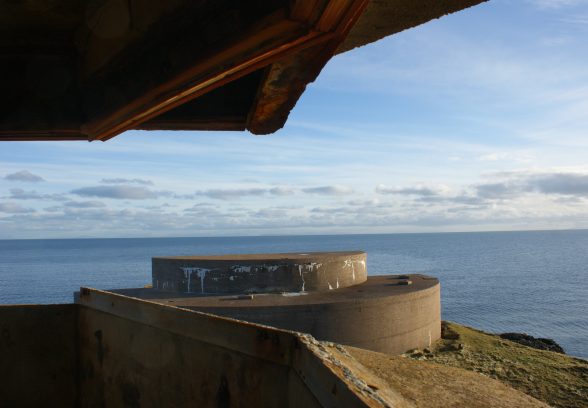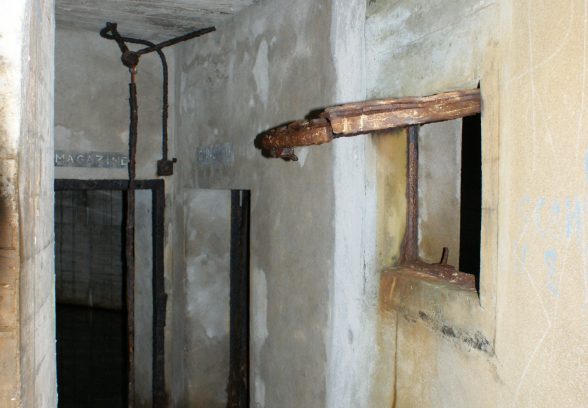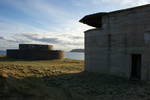This website uses cookies
This website uses cookies to enable it to function properly and to analyse how the website is used. Please click 'Close' to accept and continue using the website.





April 2011 - Arnish Point Gun Emplacements
Builder Willie Logan, by Ruairidh Campbell Moir
Stornoway, main town of the Isle of Lewis, is formed within a natural harbour, flanked by rocky headlands – the Minch channel to the mainland beyond. These headlands are witness to much colourful history from a chequered past. To the north, Holm point played centre stage in the Iolaire tragedy, Britain’s worst peacetime maritime disaster, where 205 servicemen returning from war lost their lives within miles of home. To the south, Arnish point farmhouse ‘Kildun’ was host to Bonnie Prince Charlie – the fugitive looking for safe passage. Neither did he find a ship, nor were the authorities alerted despite the bounty his head carried.
Arnish also plays host to a more recent remnant of the isle’s history. Strategically perched atop the tough conglomerate rock (‘the Stornoway beds’), gun emplacements look sturdily to sea, where once our Axis enemies roamed.
The structures are unique in Scotland for their formation. What remains of the defensive camp are two semi-circular, semi-underground gun enclosures, housing a 6” Mark 7 coast gun, guarded by an imposing watch and control tower, with two smaller enclosures each housing searchlights sit on nearby rocky headlands. Administrative and accommodation buildings were located to the north of the site and have since been removed. The guns and searchlights were removed in the early 1950s – the rusting corpse of their mangled mountings remains fused to the ground.
The scheme designer is unknown, however it is believed to have been built at the beginning of the Second World War by the major building firm Willie Logan, who went on to build the Tay Road Bridge with a similar constructional palette of reinforced concrete consisting of large pebbles and shore shingle – which brown to that distinctive marine, harled effect. Willie Logan also founded Loganair as a personal air taxi to zip him between projects – the airline still operates in Scotland today.
Built not only to serve in protection of the Hebridean port, these guns also protected convoy movements in the Minch. Those guns could fire a 45kg shell over an impressive 11 mile trajectory. Their effectiveness was, however, called into question when a submarine strayed to close range between the headlands sheltering Stornoway. Ignoring the challenge signal, the Dutch submarine Zeehond kept its course and the Arnish Guns fired with almost comic ineffectiveness: the shell completely missed the vessel, bounced across the bay on the water, and embedded itself harmlessly in the Stornoway’s Sandwickhill cemetery. The incident was a source of great embarrassment to the Royal Navy crew.
Standing here, these ghostly entombments are essays in time architecture. This theory being that the character of the buildings change, evolve and enhance over time. In this instance, one cannot help feel that the neglect of the structures has in fact added to their appeal: the dulling and eroding of concrete; the rusting steel; the attack of flora and fauna; the efflorescence-encrusted surfaces; the water staining; the sheep fouling; the human graffiti all embody the story of time passing.
However one cannot help but lament the demise of these wonderful structures, to wish they were more appreciated, and to worry for their future. These buildings need careful preservation to bring into sharp relief the very pressing danger our people faced at times of war – a situation rather more dangerous than today’s media-induced terror fears. We should remember the troubles faced by our parents and grandparents and the hardships of war on their doorstep. Monuments like the Arnish Gun Emplacements send to us a chilling visceral reminder that the war was real.
This stark reality strikes you upon encountering the many signs and impressions of human interaction around this site. Hand Stencilled signs proclaim “SHELL ROOM”, “MAGAZINE STORE”, “NO SMOKING”. Door levers, remains of glazing brackets and clips, collapsed service conduits and light switches all remind the observer that this was a real, living, breathing defensive outpost. Live ammunition was here, and was ready for use.
This is not the film set from “Der Untergang”, this place housed people charged with the protection of Stornoway and the Isles.
Something needs to be done for the future of these primitively constructed, scantly detailed weapons of war. They possess a barren beauty, and with their man-made concrete fused with nature-made conglomerate stone. Add to this their history, and the Arnish Point Gun Emplacements are firmly rooted in place.
The urgency of the predicament facing these structures is very real. The reinforcement cables spanning the large mouths in the gun housings are exposed, and completely corroded. Further evidence of serious deterioration is all around the buildings. It’s not certain how long they will last in their present state; however a re-build after a collapse would loose their authenticity. One can only hope that some capital investment can be found to make remedial repairs for the short term, with a long term objective to route out funders to make this site a real asset for the town and Scotland. If the masterplan for the surrounding area by SBA Architects is realised – this just might happen.
They are part of our past, and should be preserved for our future.
Ruairidh Campbell Moir is a student of architecture at Strathclyde University, Glasgow. He is an architectural assistant at SBA Architects Ltd in Stornoway, Isle of Lewis, which is also his home Isle. He is a council member of the Royal Incorporation of Architects in Scotland (RIAS), and member of the Western Isles Architects Group (WIAG). He spends any free time on designing small projects, drawing/painting, architectural analysis and campaigning on architectural matters.
Look for past Buildings of the Month by entering the name of an individual building or architect or browsing the drop down list.

Become a C20 member today and help save our modern design heritage.